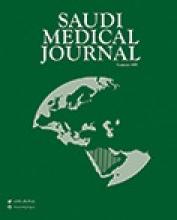Abstract
OBJECTIVE: Over utilization of emergency room services by patients with non-urgent complaints is a global problem. It results in a waste of resources, stress among the emergency room staff and an increase in waiting time for patients requiring attention. This study was carried out to establish the extent of inappropriate emergency room attendance in a Saudi community.
METHODS: Data was collected from the emergency room register, regarding the age, sex, presenting complaints, time of presentation and disposal of patients, from January 1st 1999 to March 31st 1999 at Al-Kharj Military Hospital, Al-Kharj, Kingdom of Saudi Arabia. Patients were classified in different categories according to the triage criteria of the hospital. EPI-INFO statistical software was used for calculating x2 and p vales.
RESULTS: Among the 3928 patients, 2183 (55%) were males and 1745 (44.4%) were females, while 2335 (59.4%) of the patients had primary care or non-urgent problems. In both males and females categories, 21% of the patients had respiratory tract infection followed by miscellaneous complaints like mild conjunctivitis, allergic rash, represcription for medications, minor burns (500, 12.7%, x2 = 97.49, p < 0.00001), gastrointestinal tract problems (434, 11%, x2 = 146.55, p < 0.00001) and aches and pains (304, 7.7%, x2 = 283.39, p < 0.00001). In male and female categories the 2nd most common complaints were trauma (487, 22.3%) and obstetrics and gynecological problems (325, 18.6%). The majority of the patients, 1806 or 46%, attended the emergency room during night shift (2300 hours-0700 hours). Referral rates for male and female patients were 211 (9.6%) and 331 (18.9%).
CONCLUSION: Similar to the findings of other nations, inappropriate utilization of the emergency room is a big problem in the Saudi community. The majority of the patients come with minor self-limiting complaints. Maximum rush was seen at night time. There is a need for health education of such groups of patients as well as finding alternative solutions.
- Copyright: © Saudi Medical Journal
This is an open-access article distributed under the terms of the Creative Commons Attribution-Noncommercial-Share Alike 3.0 Unported, which permits unrestricted use, distribution, and reproduction in any medium, provided the original work is properly cited.






